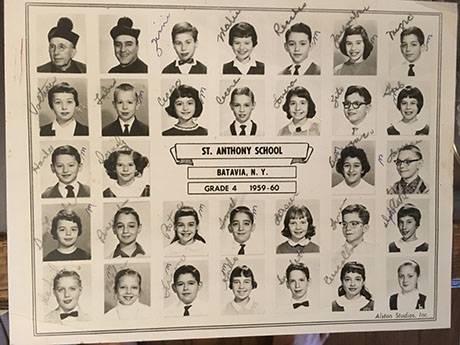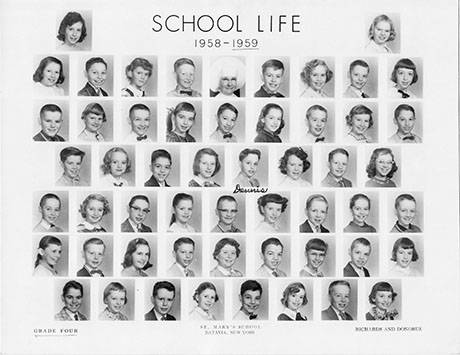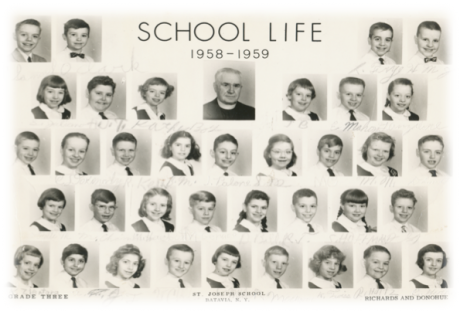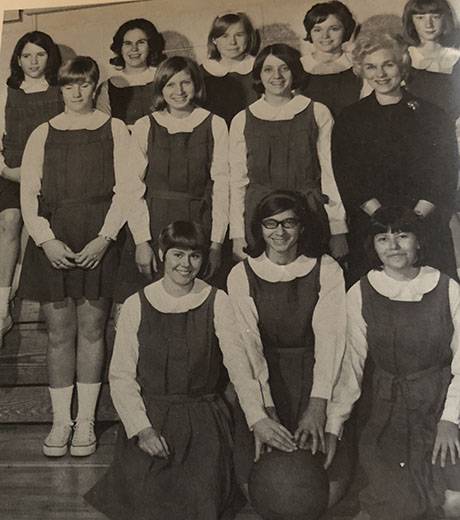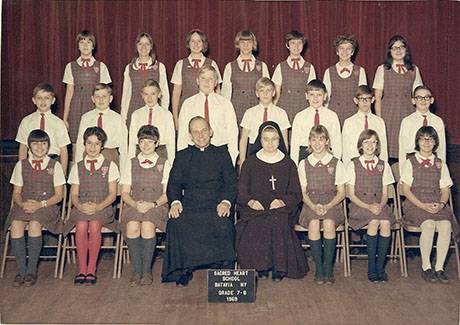
Several articles have been written on the early public schools from this area, including those still in use today. When the very first schools were built, Catholic schools were also built alongside their churches.
Rev. Thomas Cunningham established the first Catholic school in 1873. He became the first priest to settle permanently in the village. With him came six Sisters of Mercy. The sisters lived in the Davis Building on Jackson Street that served as their convent until 1873. The sisters started a school in a barn next to the convent. Due to a fire, the sisters had to move the school to a large stone building on Jackson Street that became Marshall News Store many years later.
In 1882 St. Joseph’s Parish began to build a new school and convent on Summit and East Main Street. It was a solid unadorned building with a small turret over the front door and little towers on the front corners. It had four rooms on the first floor for the younger students and three rooms above for the older children. High school students were enrolled at the school until 1912. Music lessons were taught in small spaces in the corridors.
St. Joseph’s School served as a parochial elementary school until 1959. The building was listed as unsafe for young children, so in the fall of 1959, a new school with twelve classrooms and a cafeteria was built. The old school was razed. In 1973 office space and a new gymnasium and assembly hall were added to the eastern side of the new school.
Rev. Peter Pitass started Sacred Heart School in 1904 when he organized Sacred Heart Parish. The school’s classrooms were ready for pupils by 1918. Those classrooms served the Polish community until the flood of 1942. The school and church were located at the foot of Jackson Street. By 1954 the school was also deemed a fire hazard, and plans were drawn up for a new school and church. The new school would be located east of the church facing Sumner Street. By the end of the year, a new fireproofed school building was built for $8,000.00.
In 1904 approximately 20 students were enrolled at Sacred Heart School. By 1934 the number had increased to about 60 students, and registration remained at about that level until the ‘60s. Then, in the ‘60s, enrollment began to decrease. Finally, in 1974 enrollment was so small that Sacred Heart School merged with St. Anthony’s. Thus, after 70 years, there was no longer a school in the Sacred Heart Parish.
In 1908 Rev. Hyacinthe Ciabbatoni brought two Sisters of Mercy to Batavia to organize a school. In 1909 property was bought on Liberty Street at Central Avenue; members of the parish put together two old houses to serve as a school and a parish hall. In 1930 a new school was built by Frank Homelius, one of Batavia’s native architects. He designed a school building with two floors, a social hall, and a gymnasium behind it. It was dedicated as St. Anthony’s Community Center. It was the most prominent meeting place in the city. The school had nine classrooms on two floors along central corridors, with offices on either main entrance. The basement had a nursery room, kitchen, and lavatories. It was a T-shaped building with a gymnasium used for athletics and as a meeting hall or a dining room. This community center was used for political rallies, union meetings, Grange meetings, fundraising, and Bingo. Many a bride will remember having her wedding reception at the Community Center with dinner on one floor and dancing on another.
By 1908 there were between 200 and 250 students enrolled at St. Anthony’s School. By 1970, 7th and 8th-grade students attended St. Mary’s, where junior high classes were offered. In June 2006, St. Anthony’s School closed its doors after 95 years as an educational and social activity center on Batavia’s south side.
Rev. Edward J. Ferger established St. Mary’s Elementary School when he organized the building of a Catholic High School, Notre Dame High School, in 1951. The school opened before the buildings were complete. The first-year students met at St. Anthony’s Community Center for classes until the school was finished. In 1952 St. Mary’s school was built and faced Woodrow Road. St. Mary’s had eight classrooms and a small gym in a separate building. Sisters of the Holy Cross were the first teachers at St. Mary’s, and then the school was run by the Felician Sisters. At the end of the 2003-2004 academic year, St. Mary’s Elementary School closed its doors due to limited financial resources and fewer students.
In 1951 Notre Dame High School welcomed its first class of 58 boys and girls to temporary quarters at St. Anthony’s School. Notre Dame High School was dedicated on September 6, 1952. The school has two floors with classrooms along Union Street and a large gymnasium in the rear. A cafeteria is below the gym. A small chapel and library are on the second floor. In the early years, Notre Dame’s faculty consisted of nuns and priests. There were times when up to 500 students walked the halls between classes with one-way traffic jamming corridors. Over the years, Notre Dame’s enrollment has fluctuated, but today it remains an alternative to public school education.
All students will remember the attractive uniforms the girls had to wear. Sacred Heart had a plaid jumper, St. Anthony’s a brown uniform, St. Joseph’s a blue uniform, and St. Mary’s girls wore a blue jumper crossed in the front and the back. The actual everyday uniform at Notre Dame HS was a pleated skirt and a long-sleeved blouse buttoned to the neck, and to add to the uniform’s lovely appearance was a bolero. If you rolled over the waistband of the skirt to make it shorter, you would get detention. Besides the unattractive uniforms, some might remember the classrooms overflowing with students, singing Gregorian chant at Mass, attending a High Mass on Sunday, and no meat on Friday.
One could also not forget the Notre Dame Girls’ Basketball uniform the girls had to wear in the ‘50s and ‘60s. The uniform was a royal blue, pleated, heavy cotton jumper that had to touch your knees, a long-sleeved white blouse that had to be buttoned at the top, and bloomers. The inspiring girls’ basketball team had only two girls who could run down the court, and the rest could take three steps and pass the ball. It made for a very “fast-moving” game. The windows had to be covered when the girls were playing just in case a “boy” might try to look in the window.
Over the last century, schools were established, moved, burned down, and closed. Many of these schools closed due to low enrollment, but the memories these students hold in their hearts remain. A young girl remembers living next to old St. Joseph’s School, sneaking over to the old school, and peeking in the windows. A nun would let her come in and sit and color. Her older siblings all attended the school. In the early days at St. Joseph’s School, there was not a gymnasium. Instead, students would gather every day on the blacktop in the parking lot and jump rope or shoot baskets on the outdoor basketball court.
Grade school, high school, it didn’t matter if it was a public or private school; the memories would be the same. So many will still be in touch with that special friend they hung around with in grade school and possibly high school. Stories get better with age as they are told over and over again.
Today St. Joseph Regional School is the only Catholic elementary school left in Batavia. Yet, it offers everything the public schools provide. Notre Dame High School still proudly stands on Union Street, graduating boys and girls on the same grounds their parents and grandparents stood many years ago.
